How courses can attract and retain new golfers with the help of golf cart GPS systems and technology
With golf continuing to grow in popularity, the use of golf cart GPS systems and other technologies is becoming more commonplace among forward-thinking operations.
545 million rounds of golf were played in the US in 2024 alone, according to the National Golf Foundation (NGF), representing a fifth straight year of growth.
The health of the golf industry is evident from further NGF data:
- 28 million people played on a golf course in 2024
- 6.8 million of these players were aged 18-34
- 3.4 million people played on a golf course for the first time in 2023
- 25% of golfers were people of color and 28% were female, both record highs
Even those numbers don’t show the full extent of the interest in golf, considering that 47.2 million people played either on-course or off-course golf (all golfing activities that happen outside traditional golf courses) in 2024.
Additionally, another 22.4 million people said they were “very interested” in playing golf, but did not do so during the year. This is known as latent demand.
While these stats paint a very healthy picture of the industry, there is a great deal more that can be done to attract and then retain golfers, both to the game at large and for specific operators.
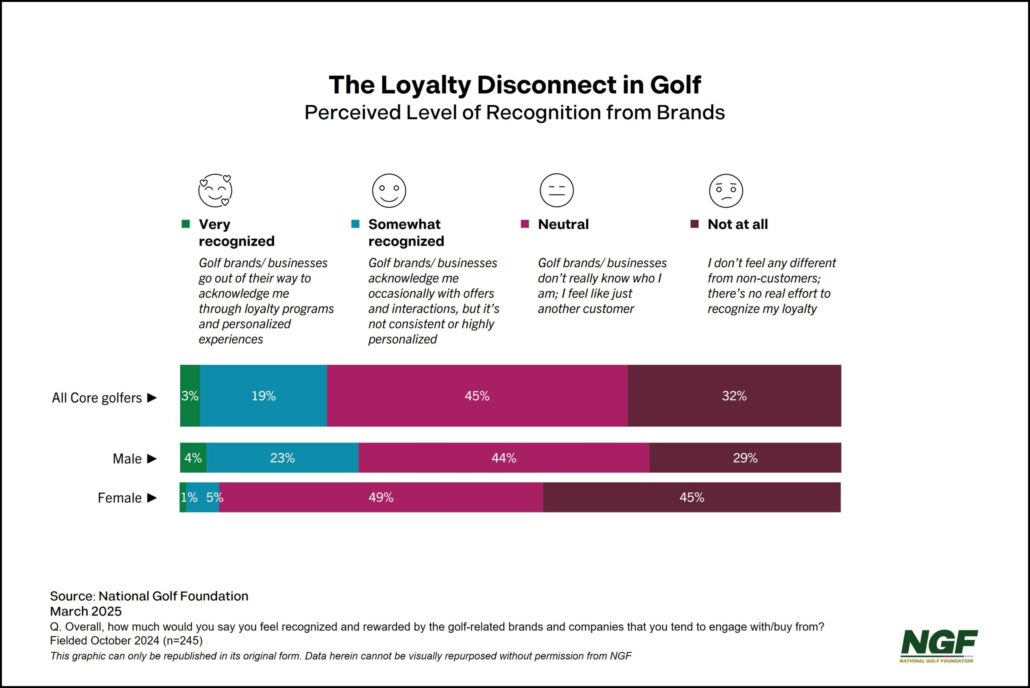
As the business of golf grows and becomes more reliant on golf cart GPS systems and automated technology to do away with what were previously in-person tasks, some of the relational dimensions of the process have taken a knock.
In another NGF study, core golfers (someone who plays 8 to 24 regulation rounds per year) were surveyed about how much they feel “recognized and rewarded by the golf-related brands and companies” that they engage with. The results were startling:
Standout stats from the study included:
- Just 50% of core golfers could recall a single meaningful interaction at a course or club that left them feeling valued or special
- 33% of golfers said the staff where they play most often don’t know their name
- Only 20% could remember a meaningful interaction with a golf consumer brand
- 50% of execs admitted that “golf lags behind other industries in customer engagement and retention innovation.”
If core golfers feel undervalued at the courses where they regularly play, it’s unlikely that first-time golfers are going to feel very welcome, either.
Understanding the golfer experience journey and where golf cart GPS can help
The golf experience can be broken down into three components: the pre-round experience, the in-round experience and the post-round experience. With each of those, there is an opportunity to use golf cart GPS and other technologies to attract and retain new golfers.
Research by the USGA shows that there are roughly 1,000 experience touchpoints spanning five phases. Engage and arrive fall under the pre-round experience, golf is the on-course experience, and exit and extend encompass the post-round experience.
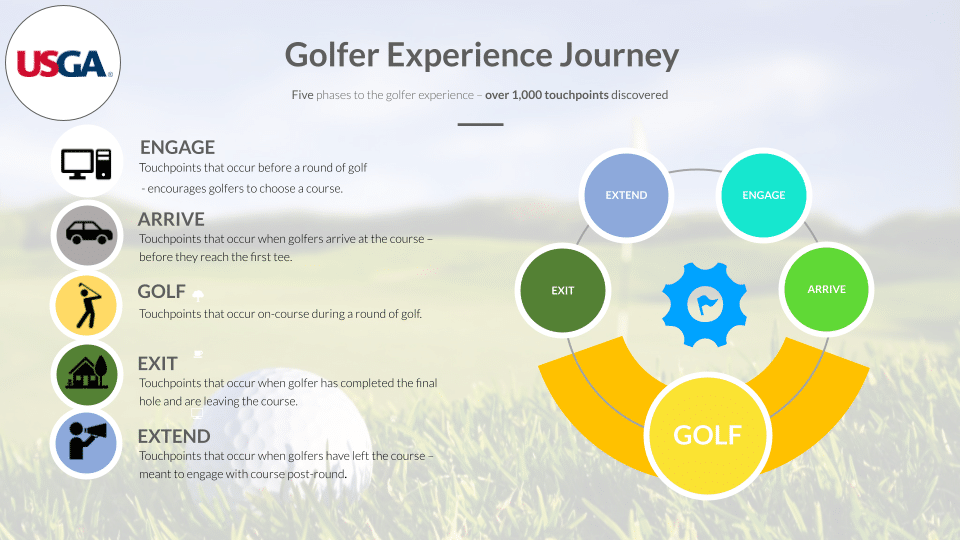
Using tech and golf cart GPS systems to enhance the pre-round experience
One might think that the golfer’s experience starts with arriving at the course, but that’s not true. From the moment a new golfer starts actively considering where to play, the journey is underway.
While golf cart GPS systems may not appear to have a direct impact on this decision, it does play a role for reasons that we will outline shortly.
Make your course discoverable
Most new golfers do their research online, and that is especially true of the 18-34 cohort that makes up the largest number of players.
The first thing operators need to do is make sure that their course is discoverable when someone searches for courses in their area. Ensuring the website is optimized for SEO means it will rank higher in the search results, with fewer than 2% of clicks going to links outside of the top five results.
Increase trust by addressing reviews
88% of consumers prefer or trust businesses that actively respond to online reviews, whether positive or negative. These interactions help build credibility and show that the business values customer input.
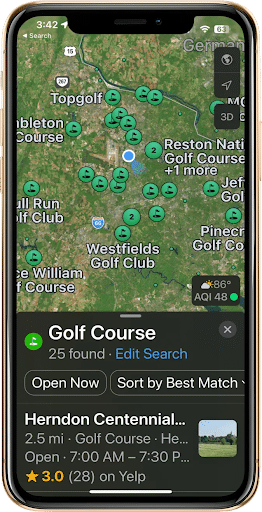
Every course should actively monitor its reviews – whether on Google, Yelp, GolfPass or any other platform – and respond accordingly. This could involve an apology and an invitation to return for a better experience, or an explanation from the course’s perspective. Either way, a response leaves a favorable impression on the next person who reads the review.
Google ratings also play a role in SEO results and search results, making it even more important to manage these, whether by setting up alerts or checking in every week across platforms.

You can really boost your Google reviews score and enhance your online reputation using surveys, directing those who respond favorably to online review sites. You can overcome negative reviews with sheer volume of positive ones.



Simplify the online user experience
The aim of most course websites, aside from private courses, is to help the user book a tee time. This should be the overarching consideration when designing the UX, especially when you consider that the average user takes just 0.05 seconds to form an opinion of the website they are visiting.
It should be immediately obvious to the user how to book a tee time, and the number of steps to complete this process must be minimized. For every additional step in an online booking process, stats show that there is a 10-15% decline in completion.
The website should also make it easy to find the course location and other important information. If a website is slow or buggy, the modern user will simply drop off and try another option.
Optimize websites for mobile
Research by Club Prophet, one of the industry’s leading point-of-sale and business management solution providers, showed that between 70% and 80% of traffic to their golf course partners was coming via mobile devices.
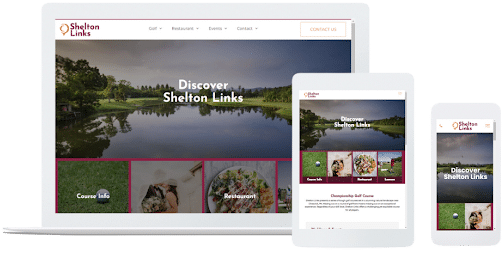
Many courses overlook this aspect and have websites that are easy to use on desktop, but cumbersome to complete a booking or find out further information via the mobile site.
Set expectations with accurate information
From the moment a potential golfer visits a website, their expectations are being set. Are you saying you are the best public course in Florida, or the best municipal course in Chicago? That is the yardstick you’ll be measured against, so you better deliver!
Providing players with information like how long it should take to play a round and where to park on arrival is very important, especially for new golfers who may feel intimidated when entering what is often seen as a ‘stuffy’ environment with rules around etiquette.
When a booking is completed, automations can be set up to send emails containing extensive pre-round information that reduces this potential source of anxiety.
A course may explain its pricing system, so that it’s clear why certain tee times cost more than others, what to do upon arrival, pace of play guidelines and expectations, and any other information that will make a new golfer feel comfortable.
Ensure that once a new player arrives at the course and starts the check-in process, they feel immediately welcome. That could be a personal touch, like mentioning them by name, and any other touchpoints you can identify.

At the start of each season, ensure all of your online channels are aligned and up to date. Own public spaces like Google Business and check them regularly, or else you are leaving an opportunity on the table.



In-round experience and the benefits of golf cart GPS systems
The in-round or on-course experience is at the heart of the entire operation, and golf cart GPS systems are invaluable in managing this.
Course conditioning and playing partners consistently rank among the top player experience factors. Operators don’t have much control over the latter, and improving course conditioning requires a sizeable budget investment, so impacting the on-course experience presents an opportunity for quick wins.
According to NGCOA research, pace of play rounds off the top 3 most critical player experience factors. There are a number of ways that on-course optimization technology will have a positive impact on both pace and on-course flow.
The importance of pace and flow of play
When a new golfer weighs up playing a round, it’s often the time it takes to play that is a critical deterrent. The round itself may only take four hours, but when you add in the travel time, warming up and possibly a drink or food afterwards, that time commitment can easily stretch to six hours.
In return for this time commitment, the golfer expects that their time is valued and they are provided with a high-quality experience, or else they will be unforgiving. Players want to know that the course they are playing is doing everything in its power to provide a positive pace and flow of play.
The 1,000 touchpoints identified by the USGA can be broken down into satisfiers (touchpoints that drive overall satisfaction) and dissatisfiers (touchpoints that negatively impact overall satisfaction). The second highest satisfier revolves around information provided about pace of play expectations (pre-round, via the starter, via on-cart signage etc), but this only serves as a positive touchpoint if the course delivers on those expectations.

New golfers, and especially those who skew younger, are used to technology like Uber and DoorDash making everyday life more efficient and eliminating frustrations. They may also have been exposed to off-course play like Topgolf, where technology is part and parcel of the experience.
Tagmarshal has turned using golf cart GPS systems to manage pace of play into a science, with full line-of-sight making effective, proactive pace management possible even in labor-constrained environments. When a course consistently provides players with an enjoyable pace and flow, it can charge more for the experience and optimize its tee sheet to create additional capacity.

Across our 700 course partners last year, our average round time was 4h06m. This shows that the so-called ‘Holy Grail’ of 4-hour rounds is realistic, but also entirely course-dependent. At Erin Hills, for example, the ideal round is 5 hours.



Ranger / marshal interactions and the perfect frustrater
Of the 1,000 touchpoints identified by the USGA, the highest-rated satisfier is etiquette and friendliness from the on-course ranger or marshal.
Just as importantly, the equally top-ranked dissatisfier is corrective pace of play actions carried out by rangers or marshals, which act as a perfect player frustrater when poorly executed. It is matched only by the speed of other players on the course.
It’s obvious from this research just how important it is for courses to manage pace, but that is made difficult by the fact that the marshal role is generally not well-liked or respected. To counter this, courses should consider renaming and reframing the role to player assistant, course ambassador, or service ambassador.
As simple as it sounds, this language shift immediately alters players’ perception of the role, especially for those who are new to the game. Additionally, the language used on-course by player assistants needs to be adjusted.
No player likes to be called slow. Instead, when a group is behind pace, refer to them as ‘out of position’ and request that they catch up a hole or get back into position. It’s temporary to be ‘out of position’ but it can be a permanent stigma to be labelled slow.
Ensuring that player assistants come across as positive, friendly and helpful, rather than simply policing pace, goes a long way to boosting on-course sentiment. Checking in with groups that are on pace and thanking them for doing so is a great way to build rapport that makes any potential pace-based interventions later in the round easier to handle.

Nobody really talks about pace of play if it was fine, but the moment it drops below a certain level, it becomes very important and impactful. You can elevate the entire experience by paying close attention to a few touchpoints in this area.



Identify first-time players and personalize on-course service
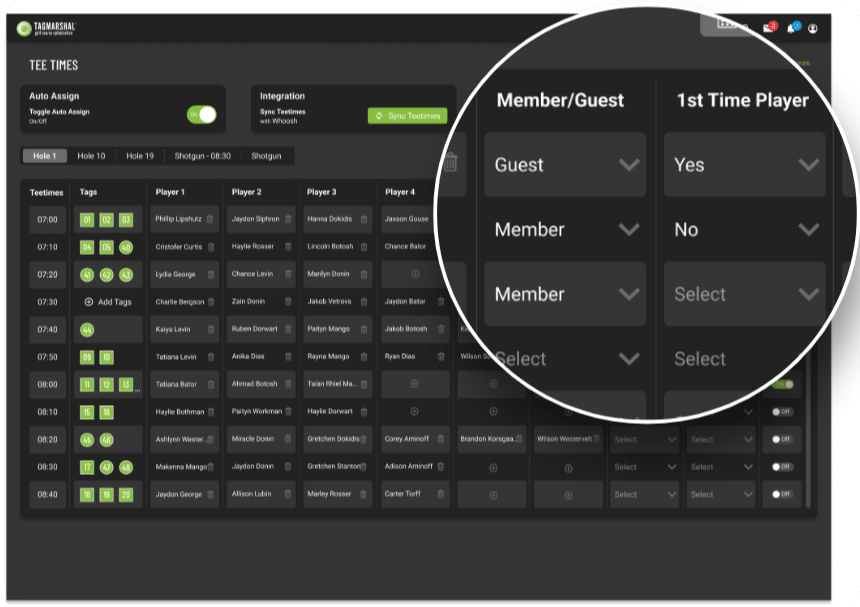
Integrated technology, like tee sheets pulling player names through into Tagmarshal’s system and assigning them to groups as they are teeing off, means operators paying close attention can offer a level of personalized service that differentiates them.
Courses should identify new golfers – whether that’s during the booking process, check-in or interactions with the starter – and input and log this information so that it’s immediately clear to on-course staff.
Equipped with this information, staff can now tailor their interactions from the outset. On top of greeting players by name, this may involve more regular check-ins, providing information and tips on playing the course’s trickier holes, letting them know about any clubhouse or pro shop specials and anything else that makes them feel welcomed and valued.

You should provide a different pre-round and in-round experience with more handholding with new golfers at your course, or first-time golfers altogether. This is a huge opportunity to create a lifetime golfer and become their home course.



The golf course remains an intimidating setting for many new golfers and finding ways to break down this barrier of entry will drive up the chances of repeat play.
A good example of how to do this is Franklin Bridge GC, a well-run, busy daily fee course in Nashville. Players use carts equipped with Tagmarshal’s 2Way screens and when staff want to alert players that they have fallen out of position using alerts sent to the screen, they choose from templates that use fun, soft language to get the message across in a more gentle way.
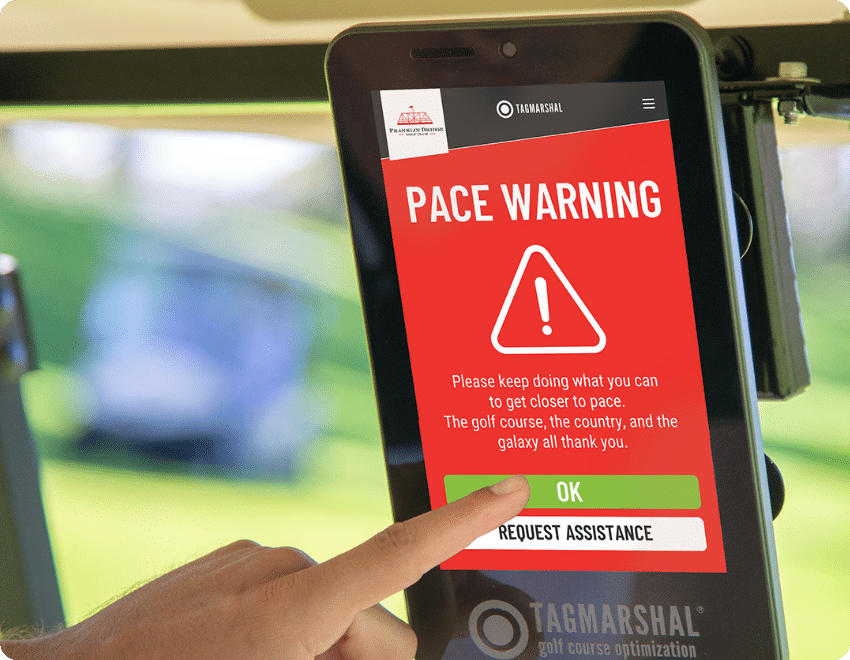
Perception versus reality
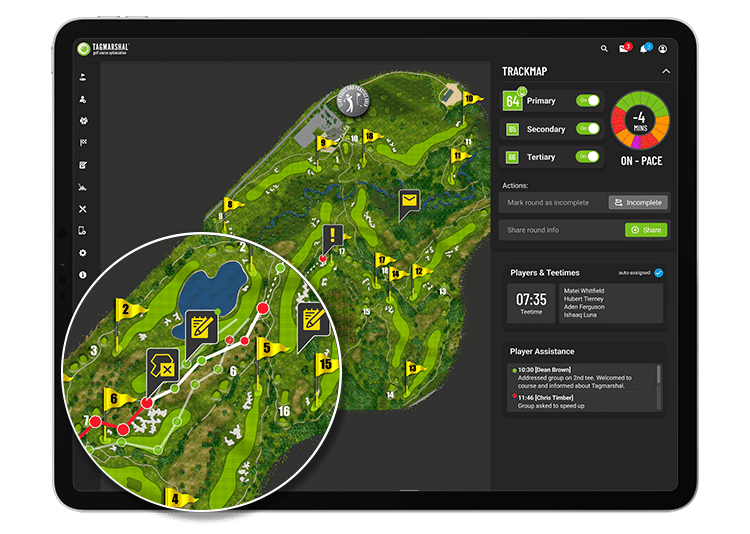
Getting around the course in 4 hours or thereabouts is a great start, but courses cannot underestimate the importance of on-course flow. Often, this becomes the perception marker for golfers because when they are waiting, whether that’s on the tee box or to hit into a green, that is when frustration builds.
A few days later, or perhaps even longer, the player only remembers this aspect of the round and leaves a scathing review. As an operator without golf cart GPS systems data to rely on, it’s extremely difficult to push back on a poor review or a player asking for their money back when you can’t pinpoint what actually happened with their round.
This is where tech like Tagmarshal’s Track Map is so helpful, as it provides a complete record of every individual round played. Courses can access this at any point and instantly see who was in the playing group, how their pace was as they progressed through the round, view any geofence breaches and on-course interactions, and other information that will help inform post-round conversations.
Courses can then counter player perception with data and push back on negative sentiment. Responding to reviews builds credibility, and others may think twice before leaving a poor review, knowing that the course has technology that records and logs each round.

When we ask players to rate pace of play after a round, what we are really measuring is the perceived pace of play from the player perspective. They don’t always know how long it took to play, but they know how they feel about it.



Post-round experiences shaped by golf cart GPS systems
Data from golf cart GPS systems and post-round surveys carried out by Players 1st, the industry’s most trusted player experience and feedback platform, have made it impossible to ignore the links between the 1,000 player experience touchpoints.
Underperforming in one touchpoint has a direct impact on others. When the pace of play or on-course flow has been bad, or at least perceived as bad, or players have been made to feel unwelcome by heavy-handed marshals, there is a clear knock-on effect on revenue drivers like the clubhouse and restaurant. The player journey is inextricably linked and understanding where a course is falling short, as well as excelling, is vital to powering its economic engine.
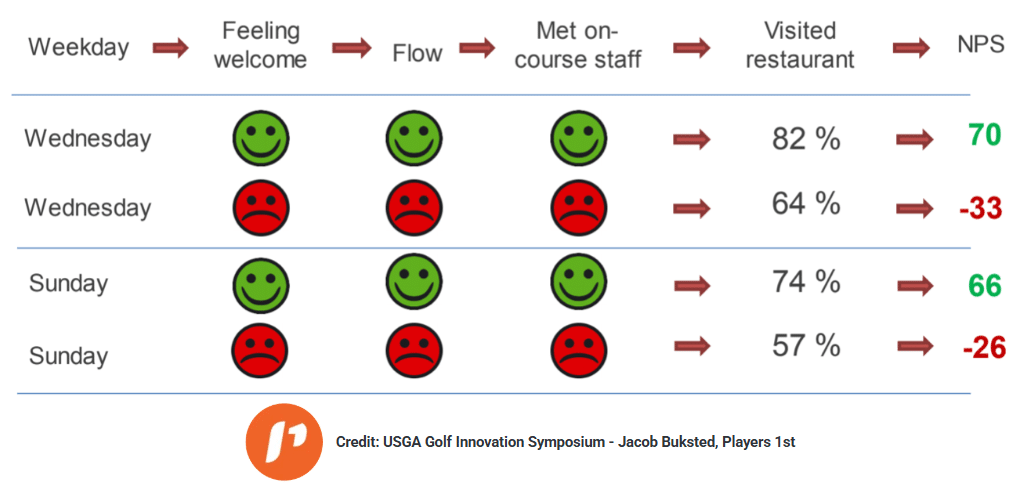
Gather post-round sentiment effectively
The post-round sentiment data that courses gather is only as good as the questions they ask.
As a general rule for the golf industry, a survey that takes on average 5 minutes to complete is acceptable, although some courses will ask only one or two questions. The issue here is that it’s then hard to drill down and figure out exactly which aspect of an operation needs attention or should be optimized without detailed data.

I have been in the survey and data business for 20 years and golf has, by far, the highest survey response rate. Players have something on their mind and they want to share it!



Industry experts like Players 1st have extensive experience in asking the right questions and they have recently partnered with the NGF to drive engagement with recreational golfers via Golfer’s Voice, a daily fee survey which is sent out after each round, thanks to integrations with tee sheet providers.
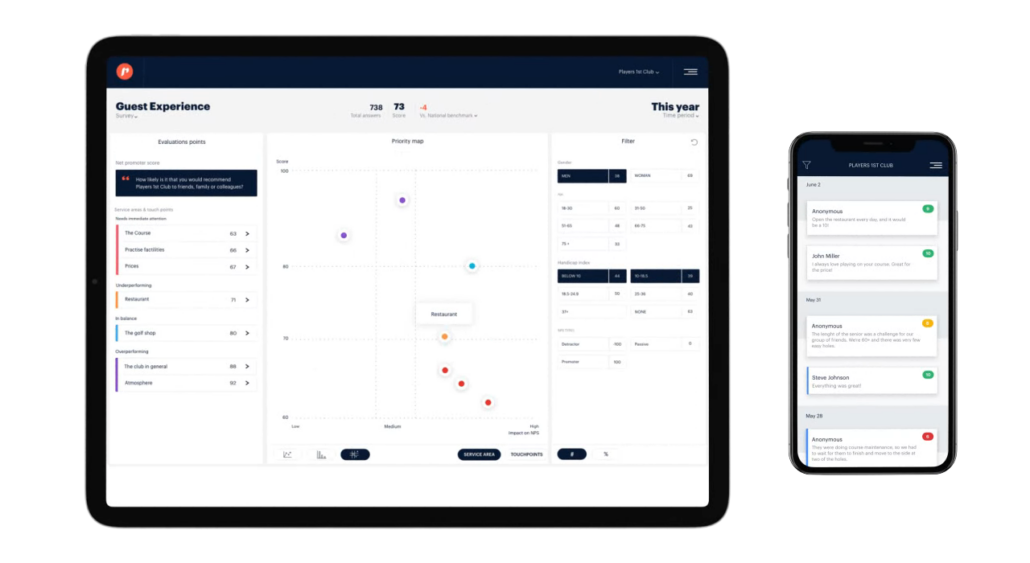
It’s important to remember that every golfer has a unique journey, which is why factoring in segmentation related to age, gender, handicap and other variables is essential. The expectations of each segmentation are different and courses need to be very specific in how they communicate with each segment.
Using advanced data and analytics, like those gathered by golf cart GPS systems and Players 1st’s surveys, courses can identify exactly what the most important touchpoints are for new golfers and prioritize action in those areas.
Where the feedback is positive, courses need to use this tactically to enhance and improve their online reputation. Encourage those who respond positively to a survey to leave a Google review, boosting scores and thus becoming more discoverable and appealing to potential new golfers who are searching online.
Implement 3 key new player retention strategies
Staggeringly, 50% of all new golfers leave the sport within the first two years. That means by the end of 2025, half of the 3.4 million people who played on a golf course for the first time in 2023 will be gone.
To remedy this, courses must make a concerted effort to provide a tailored experience to these players.
Players 1st’s research shows that there are three key new player retention strategies that stand out.
- Feel integrated into the club: New players want to feel welcome and feel a social connection to the club.
- Have others to play with: There is a huge difference in new golfer drop-off when you have a playing partner or not.
- Develop their golf game: Players want to get better and see improvement.
Those first two strategies are intricately linked, and if a new player at a course immediately feels welcomed, right from the pre-arrival experience through to on-course and post-round, that 50% drop-off rate will be reduced.
Recruit new golfer networks
Every new golfer brings with them a network of potential new golfers via their friends, family, and colleagues who haven’t necessarily been exposed to the sport before.
If a first-time golfer has a great experience at their course, they will go out and tell people, and become a powerful recruitment tool, whereas a long-term member or regular player has likely used their network and tried to recruit those around them to join in
Here’s an example of an effective new golfer offer:
“Join the club with a friend this spring! With our Buddy Membership, both of you enjoy 20% off your first year, plus 2 free lessons to kick off the season together. Golf is better with friends, and now it’s easier to start!”
Consider that by incentivizing a new player to have a friend join their journey, they are more likely to feel integrated into a club, they have someone to play with, and they can develop their game alongside a friend who is at the same skill level as them, ticking all three of the key retention strategies mentioned above.
Track online sentiment across multiple channels
Certain channels, like Google reviews and Yelp, are easy enough to monitor and check on. However, there are now so many platforms where these conversations take place that manually monitoring them all becomes time-consuming and ineffective.
To ensure that courses are aware of all online feedback, tools like Brand Listening from Club Prophet automatically crawl popular sites like X, Instagram, Reddit and many others to find all mentions related to them. This is then housed on the platform so that operators can gain a complete overview of online sentiment.
Monitoring multiple channels isn’t only about responding to unhappy customers or negative reviews. Courses also need to know what any positive reviews and discussions are centered around and use this to their advantage.

You also want to jump on positive sentiment. If players are responding well to something you are doing, you can dial that aspect of your operation up and let others know that golfers love playing at your facility for these reasons.



Learn from golf’s worrying Net Promoter Score drop-off
A course’s Net Promoter Score (NPS) is measured by asking one simple question: On a scale of 1-10, how likely are you to recommend our club to friends, family or colleagues?
Across the 10-year period before 2021, Player 1st data showed that the average NPS for daily fee courses across the US was relatively stable.
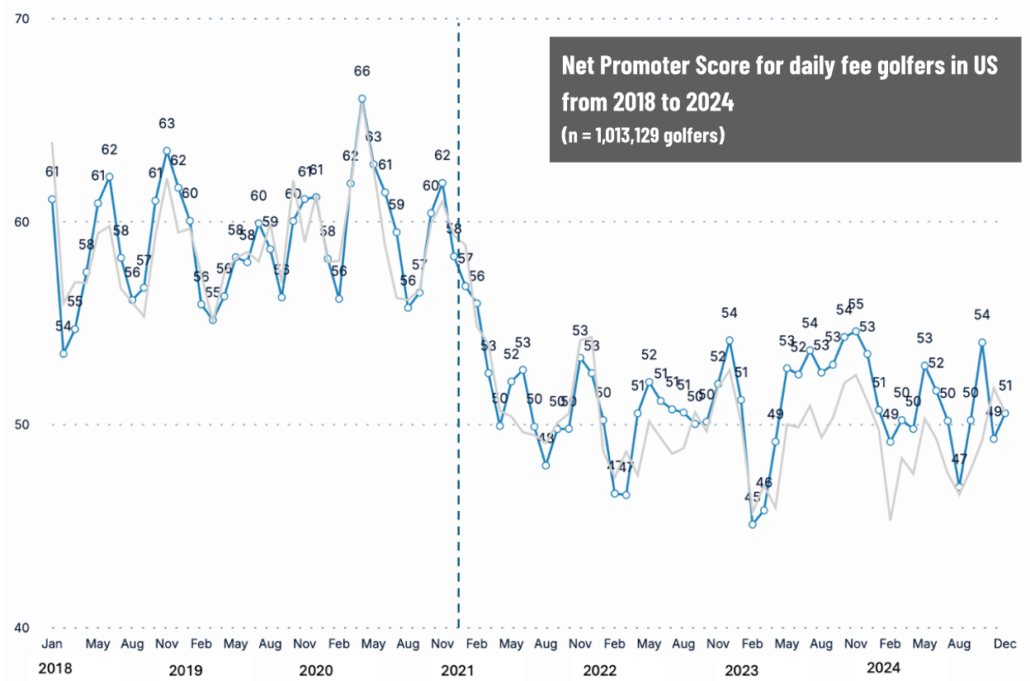
That changed in the post-COVID landscape, with data from more than a million golfers revealing a significant drop that has yet to bounce back. The 18-30 age group has the lowest satisfaction level, with three touchpoints jumping out.
These were the conditions of tee boxes, pricing (this age group has less disposable income), and on-course flow. With many new golfers falling into this age bracket, these factors should be carefully considered.

Conclusion
The year-on-year growth of golf, both in terms of total players and players taking to the course for the first time, paints a very healthy picture of an industry doing well to attract new players.
There are no guarantees this will continue, though, which makes the retention of new players all the more important. By reducing the 50% drop-off within 2 years, even by just a quarter, the long-term growth of the game can be secured.
We have outlined many strategies to help courses understand and focus on each aspect of the new golfer experience and identify where they excel and fall short. By effectively implementing these, courses will see an increase in new player retention, as well as providing a better player experience for every golfer.
 WATCH DEMO
WATCH DEMO